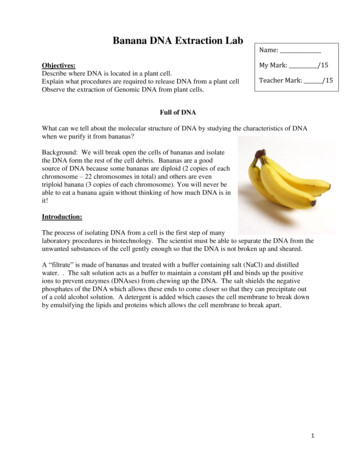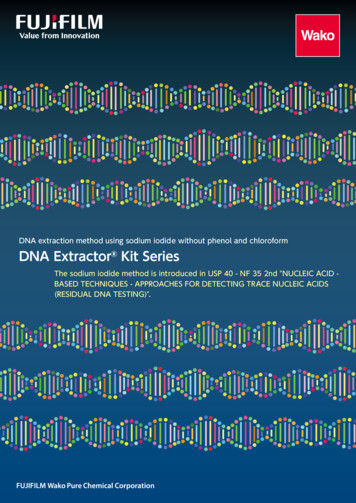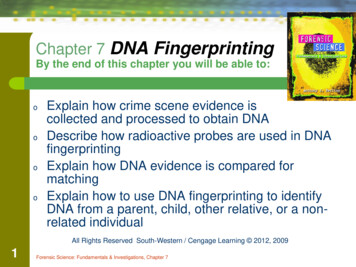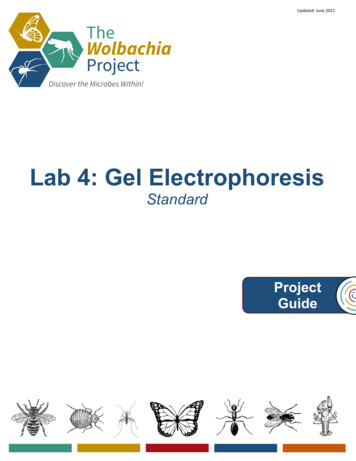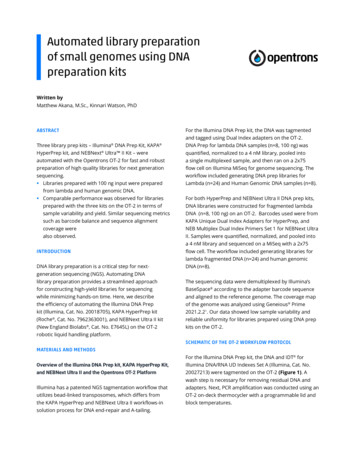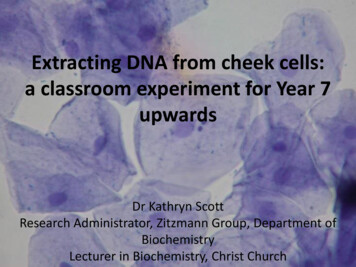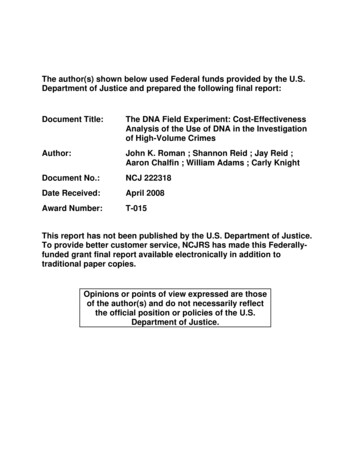
Transcription
The author(s) shown below used Federal funds provided by the U.S.Department of Justice and prepared the following final report:Document Title:The DNA Field Experiment: Cost-EffectivenessAnalysis of the Use of DNA in the Investigationof High-Volume CrimesAuthor:John K. Roman ; Shannon Reid ; Jay Reid ;Aaron Chalfin ; William Adams ; Carly KnightDocument No.:NCJ 222318Date Received:April 2008Award Number:T-015This report has not been published by the U.S. Department of Justice.To provide better customer service, NCJRS has made this Federallyfunded grant final report available electronically in addition totraditional paper copies.Opinions or points of view expressed are thoseof the author(s) and do not necessarily reflectthe official position or policies of the U.S.Department of Justice.
This document is a research report submitted to the U.S. Department of Justice. This report has notbeen published by the Department. Opinions or points of view expressed are those of the author(s)and do not necessarily reflect the official position or policies of the U.S. Department of Justice.R E S E A R C HR E P O R TThe DNA Field Experiment:Cost-Effectiveness Analysis of the Use ofDNA in the Investigation of High-VolumeCrimesresearch for safer communitiesThe DNA Field ExperimentApril 2008John K. RomanShannon ReidJay ReidAaron ChalfinWilliam AdamsCarly KnightURBAN INSTITUTEJustice Policy Center
This document is a research report submitted to the U.S. Department of Justice. This report has notbeen published by the Department. Opinions or points of view expressed are those of the author(s)and do not necessarily reflect the official position or policies of the U.S. Department of Justice.This document was prepared under a grant from the National Institute of Justice.Copyright March 2008. The Urban Institute. All rights reserved. Except for short quotes,no part of this report may be reproduced or utilized in any form or by any means,electronic or mechanical, including photocopying, recording, or by information storage orretrieval system, without written permission from the Urban Institute.The Urban Institute is a nonprofit, nonpartisan policy research and educationalorganization that examines the social, economic and governance problems facing thenation. The views expressed here are those of the authors and should not be attributed tothe Urban Institute, its trustees or its funders.URBAN INSTITUTEJustice Policy Center2100 M STREET, NWWASHINGTON, DC 20037www.urban.org
This document is a research report submitted to the U.S. Department of Justice. This report has notbeen published by the Department. Opinions or points of view expressed are those of the author(s)and do not necessarily reflect the official position or policies of the U.S. Department of Justice.TABLE OF CONTENTSEXECUTIVE SUMMARY . . . . . . . . . . . . . . . . . . . . . . . . . . . . . . . . . . . . . . . . . . . . . . . . . . . . . . . . . . . . . . . . . . . . . . . . . . . . . . . . . . . . . . . . . . 3Suspect Identification, Arrest and Prosecution. 4Fingerprint vs DNA Evidence. 4Criminal History of Identified Suspects . 4Best Practices in DNA Evidence Collection. 4Cost-Effectiveness of DNA. 5Discussion and Implications for Policy and Practice. 5CHAPTER 1—THE USE OF DNA IN BURGLARY INVESTIGATIONS. . . . . . . . . . . . . . . . . . . . . . . . . . . . . . . . . 7The Burglary Investigation Process. 9Prevalence and Incidence of Offending by Burglars . 9Career Criminals .10Capture of Career Criminals.10Career Burglars.11DNA Evidence.11Research Linking DNA Evidence to Case Outcomes .12Databases Supporting DNA Analysis.13The Combined DNA Index System (CODIS).14The National DNA Index System (NDIS).14The State DNA Index System 17The Local DNA Index System (LDIS).17Phoenix, Arizona.17Orange County, California.18Denver, Colorado.18Los Angeles, California .18Topeka, Kansas .18The Use of DNA Matches in the Investigation.18CHAPTER 2—RESEARCH DATA AND METHODS . . . . . . . . . . . . . . . . . . . . . . . . . . . . . . . . . . . . . . . . . . . . . . . . . . . . . . . 19Pooling vs. Site-Specific Analysis.20Issues in Implementation.20Other Limitations .22The Experimental Sites .22Overview of Evidence Collection and Processing .23The Research Design.24The Randomized Design.25Cost Analysis .28Impact Analysis.32Outcome Analysis .33CHAPTER 3—BEST PRACTICES . . . . . . . . . . . . . . . . . . . . . . . . . . . . . . . . . . . . . . . . . . . . . . . . . . . . . . . . . . . . . . . . . . . . . . . . . . . . . 35Data and Methods .36Multivariate Models .37Results .38The DNA Field Experiment
This document is a research report submitted to the U.S. Department of Justice. This report has notbeen published by the Department. Opinions or points of view expressed are those of the author(s)and do not necessarily reflect the official position or policies of the U.S. Department of Justice.CHAPTER 4—DENVER, COLORADO . . . . . . . . . . . . . . . . . . . . . . . . . . . . . . . . . . . . . . . . . . . . . . . . . . . . . . . . . . . . . . . . . . . . . . . . 46Context for the DNA Demonstration.47Protocols (Proposed).47Protocols (Implemented) .47Training .47Case ation .51Descriptive Statistics.52Cost .52Cost Data Collection.52Costs by Stage.53Processing an Average Case.55Other Costs.57Outcomes .59Descriptive Statistics .59Cost-Effectiveness Analysis.67CHAPTER 5—LOS ANGELES, CALIFORNIA. . . . . . . . . . . . . . . . . . . . . . . . . . . . . . . . . . . . . . . . . . . . . . . . . . . . . . . . . . . . . . 68Context for the DNA Demonstration.68Protocols (proposed).68Protocols (Implemented) .69Case Processing.70Police.70Crime Lab.70Prosecution.72Collaboration .73Descriptive Statistics.73Cost .73Cost Data Collection.74Case Processing in Los Angeles.74Processing an Average Case.77Other Costs (not included in cost estimates).79Outcomes .80Descriptive Statistics .80CHAPTER 6—ORANGE COUNTY, CALIFORNIA . . . . . . . . . . . . . . . . . . . . . . . . . . . . . . . . . . . . . . . . . . . . . . . . . . . . . . . . . 86The DNA Field Experiment in Orange County, California.87Protocols (Proposed).87Protocols (Implemented) .87Case Processing.88Police.88Crime Lab.88Prosecution.90Collaboration .91Cost .92Cost Data Collection.92Case Processing in Orange County .93Processing an Average Case.95Other Costs.97Outcomes .98Descriptive Statistics .99CHAPTER 7—PHOENIX, ARIZONA . . . . . . . . . . . . . . . . . . . . . . . . . . . . . . . . . . . . . . . . . . . . . . . . . . . . . . . . . . . . . . . . . . . . . . . . 105Context for the DNA Demonstration.105Protocols (Proposed).105Protocols (Implemented) .106Training .106Case on .109Descriptive Statistics.110The DNA Field Experiment
This document is a research report submitted to the U.S. Department of Justice. This report has notbeen published by the Department. Opinions or points of view expressed are those of the author(s)and do not necessarily reflect the official position or policies of the U.S. Department of Justice.Cost .110Cost Data Collection.111Case Processing in Phoenix.111Processing an Average Case.114Other Costs.116Outcomes .117Descriptive Statistics .117CHAPTER 8—TOPEKA, KANSAS . . . . . . . . . . . . . . . . . . . . . . . . . . . . . . . . . . . . . . . . . . . . . . . . . . . . . . . . . . . . . . . . . . . . . . . . . . 123Context for the DNA Demonstration.123Protocols (proposed).123Protocols (Implemented) .124Training .124Case aboration .126Cost .127Cost Data Collection.127Case Processing in Topeka .128Processing an Average Case.130Other Costs.132Outcomes .133Descriptive Statistics .133CHAPTER 9 – CROSS-SITE ANALYSIS AND DI SCUSSION. . . . . . . . . . . . . . . . . . . . . . . . . . . . . . . . . . . . . . . . . 139Overview.139Results .139Outcomes of Cases with DNA Evidence.139The Contribution of DNA Evidence to Case Outcomes .140Comparing Outcomes for Fingerprint and Biological Evidence.142Cost of DNA Processing in High Volume Crimes .143The Cost of Processing a Case by Stage.144Cost-Effectiveness .146Characteristics of Suspects in High Volume Property Crimes .146Discussion.147Limitations.149CHAPTER 10 -IMPLICATIONS FOR POLICY AND PRACTICE . . . . . . . . . . . . . . . . . . . . . . . . . . . . . . . . . . . . . 150Changes in Policing.150Demand for Laboratory Services .151Investigation and Prosecution.
Cost-Effectiveness Analysis of the Use of DNA in the Investigation of High -Volume Crimes John K. Roman Shannon Reid Jay Reid Aaron Chalfin William Adams Carly Knight RESEARCH REPORT April 2008 URBAN INSTITUTE research for safer communities Justice Policy Center This document is a research report submitted to the U.S. Department of Justice.


